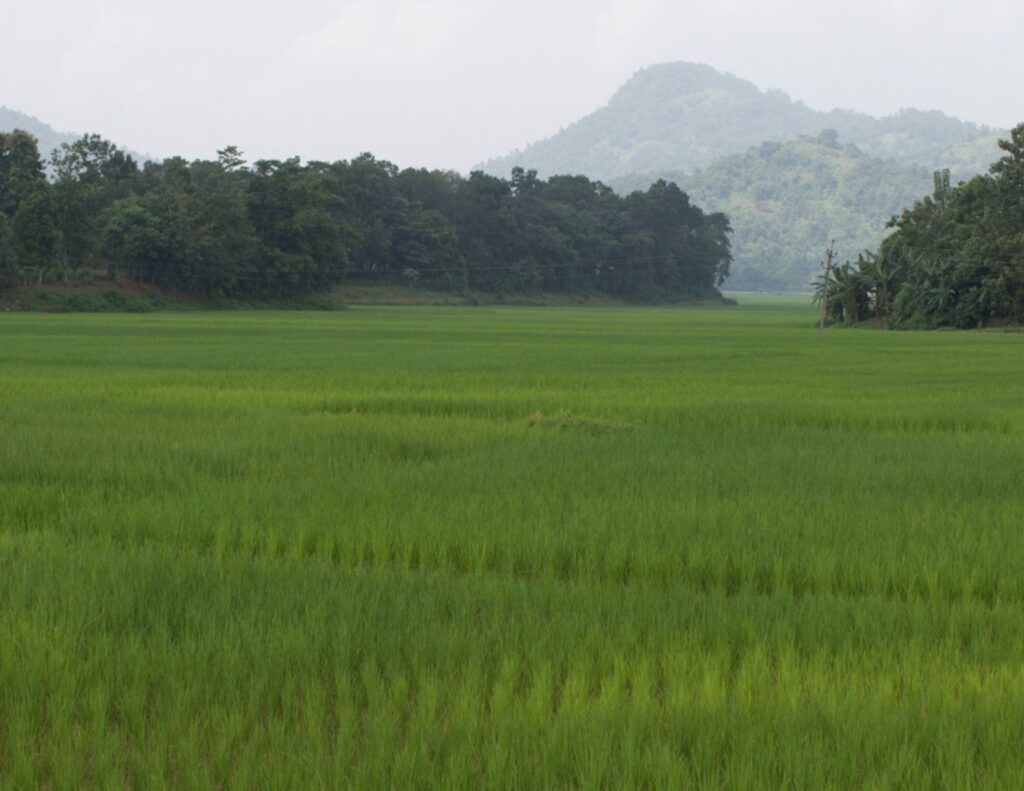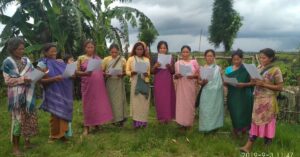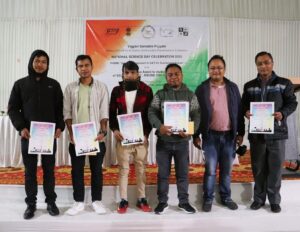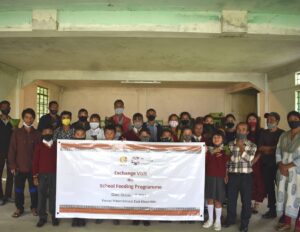On the 22nd of April 2022, the Career Guidance and Counseling Committee, Sohra Government College, organized a one day workshop themed “Indigenous Peoples’ Food Systems – A game changing solution in the context of climate change”. The College invited NESFAS and Charlotte Milbank, a PhD scholar from University of Cambridge, to take part in the program. Charlotte Milbank is writing her thesis on wild foods and has selected three indigenous communities from Meghalaya to be part of the study. Her lecture titled ‘Wild Foods for Sustainable Food Security and Health within Indigenous Peoples’ Food Systems’ was the main presentation of the workshop. In it, she talked about the importance of wild foods in the context of hunger, malnutrition and environmental degradation. In the end, she also touched on the importance of her research for policy implications. The team from NESFAS also gave individual presentations, one of which was on how Indigenous Peoples’ Food Systems can act as a bulwark against biodiversity loss. During the Q&A session, both Charlotte and the NESFAS team were asked questions, one of which was related to the issue of growing landlessness in Meghalaya.
An audience in the program raised the issue of decline of agricultural land in the State. In Ri-Bhoi, according to him, this is driven by people from Shillong buying up a lot of the fertile land and filling them up with soil for building petrol pumps. Indeed, purchase of land by people from outside the district has become quite common in Ri Bhoi. Land is bought not only for building petrol pumps, but also for building farm houses or giving it again on rent to someone else. There are many, though, who are buying land not for its use value but for its exchange value, i.e., land is bought only to be resold after a few years for a profit. In light of the fact that the 2011 Census has categorized 76% of the households in Meghalaya as being landless it might be tempting to assume that the majority of such households are from Ri-Bhoi. This, however, would be a big mistake. A lot of them, quite possibly, are from East Khasi Hills.
A few weeks ago during a participatory natural resources assessment workshop organized by NESFAS (North East Slow Food and Agrobiodiversity Society) in a village in East Khasi Hills, it was revealed that no one in the particular village owned the land on which they have built their houses and where they practice their farming. The entire land is actually owned by a particular clan which has leased it to the residents of the village for a period of 15 years. The durbar shnong then leased the land to certain households in the village who would further lease it to the other households for a period of 4 years. In effect, there are three layers of land ownership in the village. In such a situation it is the ones at the bottom who ends up paying the most for using the land. This happens because the owners above have to get a surplus rent in order to make profit. For example, if the rent collected by the clan is Rs. 2000/- per acre per year, the durbar shnong who have leased the land to the households have to collect a rent of more than Rs. 2000/- per acre per year to cover the original cost and make a profit. The latter would then have to impose a rent of more than that new amount to the households below them (the third lessee) to again cover the cost and earn a profit. In the end, those who can’t afford are actually spending the most. This is completely against the tenets of social justice which among other things is based on fairness and equity.

The village has existed at least since colonial times. But over this long period, the households in the village have never owned the land on which they lived and worked. It is not only depressing but also highly disturbing – an indigenous community being ‘homeless’ in their own land. The most disturbing thing however, as found from NESFAS’ own research, is that this is a common feature in many parts of East Khasi Hills. This is not a unique situation. Hence, the question that arises is how old is the arrangement? This is something which is not very clear. The distinction between private land (ri kynti) and community land (ri raid) appears to have existed in the past. Colonialism, however, intensified the distinction leading to the surge of the former at the expense of the latter. For more details on the process one can refer to the report ‘Land tenure system and landlessness in Meghalaya: a Literature Review’ by Jakrimre Momin and Bhogtoram Mawroh from the NESFAS website. Another important document that can be very helpful in understanding the changes in land tenure system (i.e., from community to private property regime mode) is the 2019 ‘Citizen’s Report on the Unregulated Coal Mining in Meghalaya’. This document can be accessed from https://raiot.in/download-citizens-report-on-the-unregulated-coal-mining-in-meghalaya/. The author of the present article was a member of the drafting committee which submitted the report to the Supreme Court. The Court cited the report in its final judgment on coal mining.
There might be some who will argue that the present arrangement is not really a big problem. Since it is happening between members of the same indigenous community, i.e., between para doh para snam, there won’t be any exploitation. The experience of the village mentioned in this article however proves otherwise. Few years ago, the land owning clan proposed that every household in the village would have to pay a kind of house tax. This was rejected by the village durbar shnong citing that it goes against age-old traditions and culture of the Khasi community. There is in fact a precedent to this which comes from the Jaintia Hills.
In pre-colonial times, the Jaintia Kingdom was one of the strongest kingdoms to have emerged from the hills of Meghalaya. It in fact had spread its dominion to the plains of Sylhet where Jaintiapur was established as the capital of the kingdom. Expectedly, the arrival of the British in the region brought the Jaintia Kingdom into conflict with them. Finally, on March 15, 1835, the ancient kingdom lost its independence and was conquered by the British. This however did not mean the complete subjugation of the Jaintia people to the will of the foreigners.
In 1860, a House Tax was imposed in Jaintia Hills. The public pronouncement of this imposition was made by Manik Pakyntein in a Dorbar held at Mïnkoi Pïrdi in 1859. In the same year, many more taxes were imposed which included Income Tax and duties on trade and other commodities. The Jaintia people however resented this move to tax them. The final straw which sparked the rebellion was the decision of the British Government to stop a local festival. This uprising was led by U Kiang Nangbah. Born to Ka Rimai Nangbah at Tpep-Pale in Jowai, he was a farmer whose maternal uncle had also fought against the British. When Kiang Nangbah heard about the imposition of the tax, he declared that, “Natives do not pay taxes to the foreigners”. The uprising only ended when Kiang Nangbah was captured by the British after being betrayed by one of his comrades. He was tried and hanged at Iawmusiang in 1862.
What the clan proposed to the village was akin to the house tax imposed by the British. The fact that it was done by members of the indigenous community who rose up against outsiders who wanted to do the same, points to a very sad development. It represents the dilution of the ethos and the value systems which has held the community together for thousands of generations. But most of all, it represents the precarious situation of the landless population in the State. It’s very possible that in the future the situation might deteriorate to the extent that a new Kiang Nangbah will have to emerge; this time not to fight against outsiders but against enemies from within (like his comrade who betrayed him) to save the indigenous community.
This article was originally published in The Shillong Times



